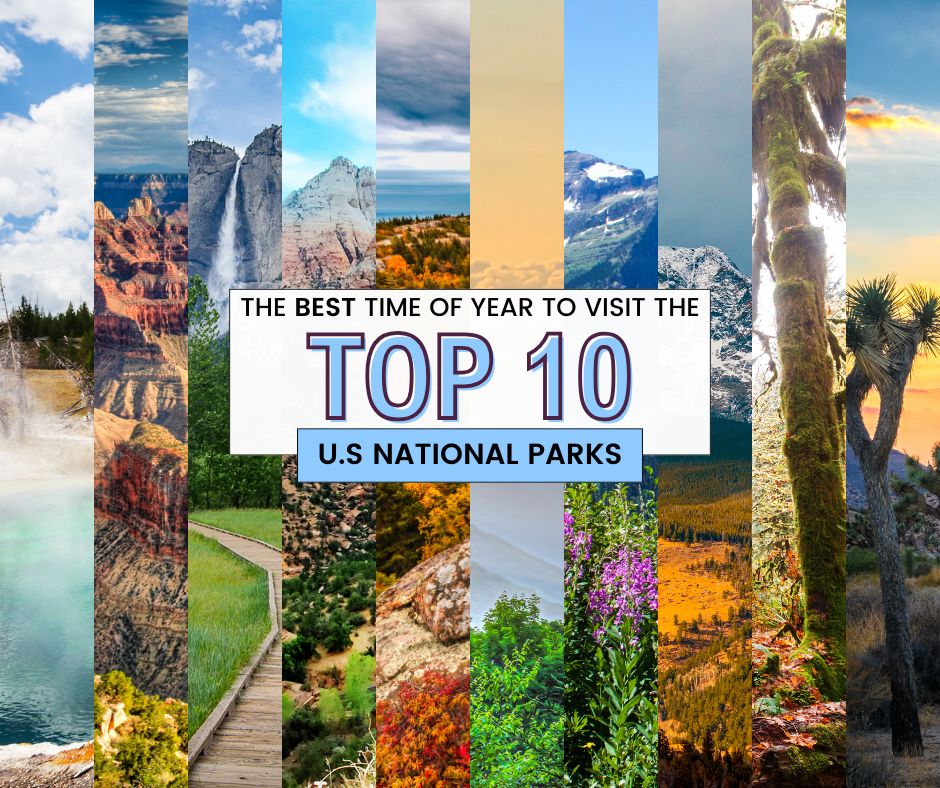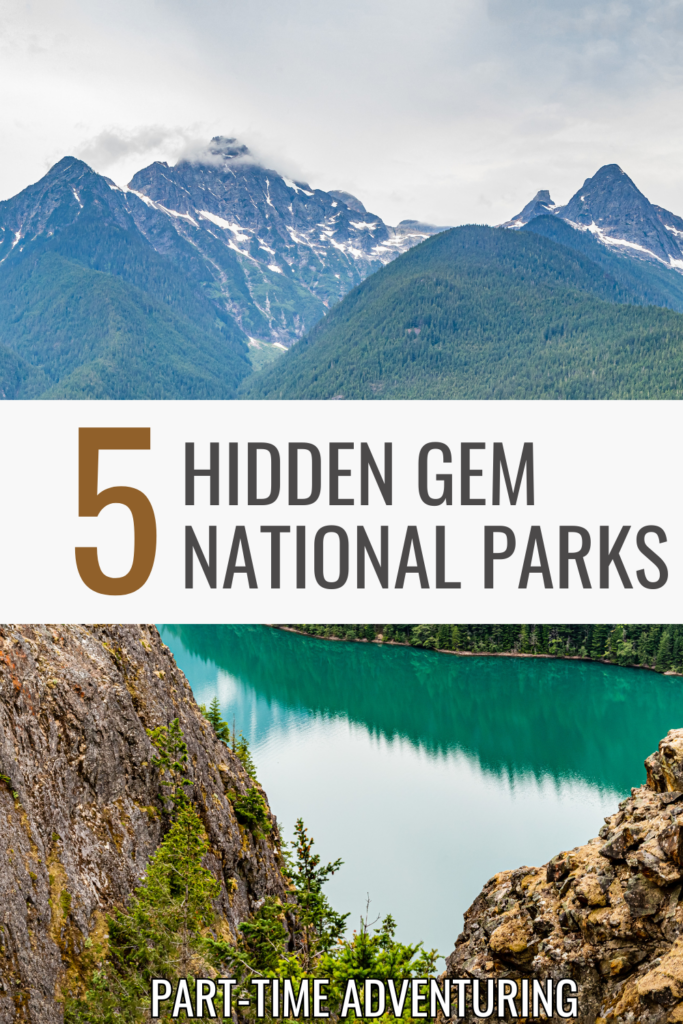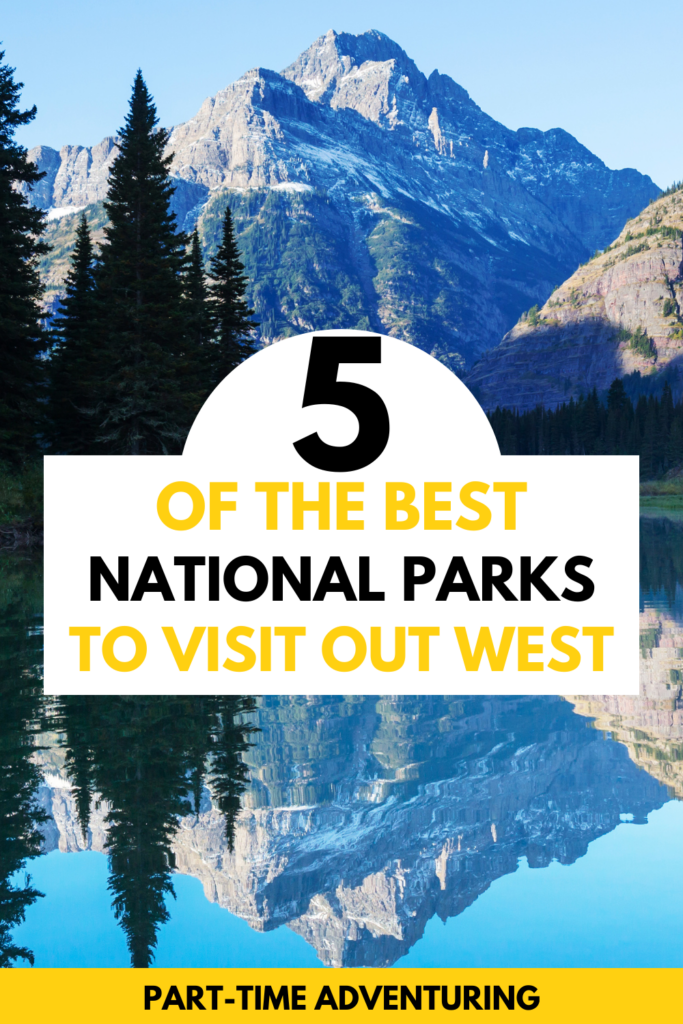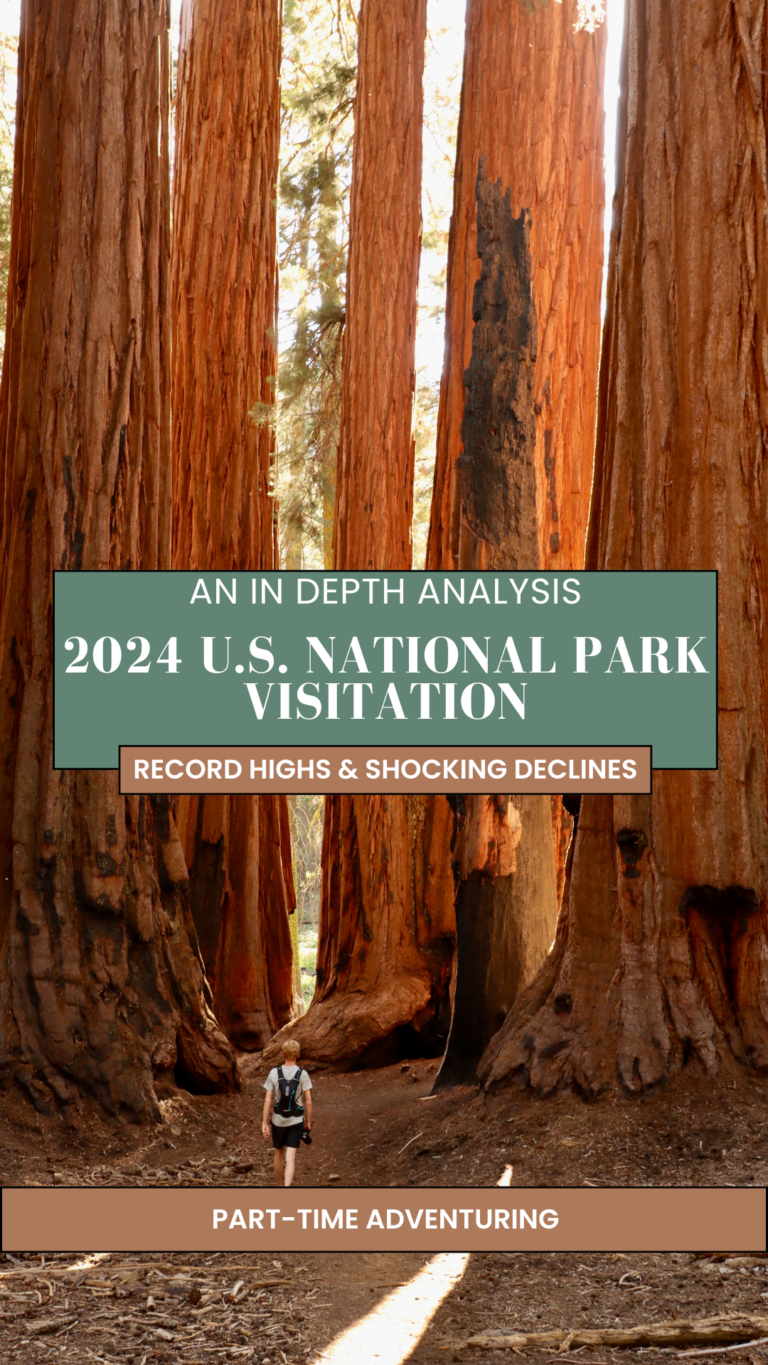The U.S. National Park Service continues to attract millions of visitors each year, offering opportunities to experience some of the most iconic and remote landscapes in the world. Overall The National Park Service ( NPS) reported a record 331.9 million recreation visits in calendar year 2024. In 2024, for the 63 U.S National Parks, total visitors increased by 2.05%, with a rise of 1,897,363 visitors compared to 2023. Here’s a closer look at the visitation patterns for the most and least visited national parks, along with the parks that experienced significant increases or decreases in visitors.
Here is the direct link to the NPS database of these numbers.
Total Visitors in 2023 and 2024
- Total Visitors in 2023: 92,390,204
- Total Visitors in 2024: 94,287,567
- Overall Increase: +1,897,363 visitors (an increase of about 2.05%)
Top 10 Most Visited National Parks (2024 vs. 2023)
2024 Annual Visitors

- Great Smoky Mountains NP – 12,191,834
- Zion NP – 4,946,592
- Grand Canyon NP – 4,919,163
- Yellowstone NP – 4,744,353
- Rocky Mountain NP – 4,154,349
- Yosemite NP – 4,121,807
- Acadia NP – 3,961,661
- Olympic NP – 3,717,267
- Grand Teton NP – 3,628,222
- Glacier NP – 3,208,755
Consistent Parks
Several parks have consistently held strong positions in the top 10 list, showing their widespread appeal and staying power. The Great Smoky Mountains NP continues to lead the list, with Zion NP, Grand Canyon NP, Yellowstone NP, Rocky Mountain NP, Yosemite NP, Acadia NP, Olympic NP, and Grand Teton NP all remaining in the top 10 for both 2023 and 2024. These parks offer easy access, diverse ecosystems, and ample opportunities for outdoor activities, which draw large numbers of visitors year after year.
Notable Changes
- Glacier NP replaced Joshua Tree NP in the 2024 list. This shift may reflect a growing interest in Glacier’s more remote wilderness and rugged beauty, contrasting with Joshua Tree’s increasing crowds and accessibility issues.
- Joshua Tree NP dropped off the top 10 list for 2024, likely due to overcrowding and a reduction in accessibility. The absence of Joshua Tree from the top 10 suggests a shift in visitor preference towards less crowded, more tranquil parks.
Top 10 Least Visited National Parks (2024 vs. 2023)
2024 Annual Visitors

- Gates of the Arctic NP & PRES – 11,907
- North Cascades NP – 16,485
- Kobuk Valley NP – 17,233
- Lake Clark NP & PRES – 18,505
- National Park of American Samoa – 22,567
- Isle Royale NP – 28,806
- Katmai NP & PRES – 36,230
- Wrangell-St. Elias NP & PRES – 81,670
- Dry Tortugas NP – 84,873
- Great Basin NP – 152,068
Consistent Parks
The least visited parks remain largely consistent from year to year, with many of these parks being remote, difficult to access, or lacking extensive visitor facilities. Gates of the Arctic NP & PRES, National Park of American Samoa, Lake Clark NP & PRES, Kobuk Valley NP, Isle Royale NP, Katmai NP & PRES, North Cascades NP, Wrangell-St. Elias NP & PRES, Dry Tortugas NP, and Great Basin NP are on both the 2023 and 2024 lists. These parks appeal to visitors seeking seclusion and rugged wilderness but often come with challenges like limited infrastructure and difficult access.
Shifting Numbers
- Voyageurs NP made its way onto the least visited list in 2024, replacing Joshua Tree NP from the 2023 list. Voyageurs, being a more remote park with limited access, appeals to fewer visitors but offers a unique and tranquil experience.
- Great Basin NP remains one of the least visited parks, despite its distinctive landscape. The remote location and lack of major infrastructure likely contribute to its continued low visitation.
The 10 National Parks with the Largest Decrease in Visitors (2023 vs. 2024)
| National Park | 2023 Annual Visitors | 2024 Annual Visitors | % Change |
|---|---|---|---|
| North Cascades NP | 40,351 | 16,485 | -59.15% |
| Channel Islands NP | 328,746 | 262,581 | -20.13% |
| Wind Cave NP | 592,459 | 489,399 | -17.4% |
| Lassen Volcanic NP | 418,978 | 357,651 | -14.64% |
| Great Sand Dunes NP & PRES | 512,219 | 437,661 | -14.56% |
| Hawaii Volcanoes NP | 1,620,294 | 1,433,593 | -11.52% |
| Biscayne NP | 571,242 | 512,213 | -10.33% |
| Voyageurs NP | 220,825 | 199,030 | -9.87% |
| Crater Lake NP | 559,976 | 504,942 | -9.83% |
| Joshua Tree NP | 3,270,404 | 2,991,874 | -8.52% |
Analysis of Decreases
Parks like North Cascades NP and Channel Islands NP saw significant decreases in visitation. These parks tend to be more remote and harder to reach, which may explain the decline. Joshua Tree NP, despite being iconic, experienced a drop likely due to overcrowding and infrastructure challenges.
The 10 National Parks with the Largest Increase in Visitors (2023 vs. 2024)
| National Park | 2023 Annual Visitors | 2024 Annual Visitors | % Change |
|---|---|---|---|
| National Park of American Samoa | 12,135 | 22,567 | +85.97% |
| Redwood NP | 409,105 | 622,883 | +52.26% |
| Sequoia NP | 980,567 | 1,309,573 | +33.56% |
| Death Valley NP | 1,099,632 | 1,440,484 | +30.1% |
| Olympic NP | 2,947,503 | 3,717,267 | +26.12% |
| Virgin Islands NP | 343,685 | 423,029 | +23.09% |
| Carlsbad Caverns NP | 394,121 | 460,474 | +16.84% |
| Mammoth Cave NP | 654,450 | 747,042 | +14.15% |
| Capitol Reef NP | 1,268,861 | 1,422,490 | +12.11% |
| Lake Clark NP & PRES | 16,728 | 18,505 | +10.62% |
Analysis of Increases
Several parks saw significant increases in visitation, notably National Park of American Samoa, Redwood NP, and Sequoia NP, which could be driven by new attractions, greater awareness, and improved accessibility. Death Valley NPalso experienced a notable rise in visitors, likely due to growing interest in desert landscapes and the unique experiences offered in the park.
Other Analysis of the Annual Visitor Number Trends

As the popularity of national parks continues to rise, several factors contribute to the annual shifts in visitation numbers. In this analysis, we’ll dive deeper into the data behind the trends, exploring not only the parks that saw the largest increases and decreases in 2024 but also the underlying influences shaping the visitor landscape. From the undeniable effect of social media to the growing interest in remote, lesser-known parks, the numbers tell a compelling story about how people are experiencing these treasured natural spaces. This year’s statistics highlight not only which parks are drawing the largest crowds but also offer insight into how travel behavior is evolving and the appeal of quieter, more isolated destinations.
Social Media Influence on Visitor Numbers
The influence of social media continues to play a significant role in the popularity of national parks. Iconic spots like Zion NP, Yosemite NP, and Grand Canyon NP benefit from extensive exposure on platforms like Instagram, Facebook, and TikTok. This has the potential to lead to an increase in first-time visitors who want to experience these destinations for themselves. On the other hand, lesser-known parks might not benefit from the same exposure, leading to fewer visitors but a more tranquil experience for those in the know.
Increased Interest in Remote and Lesser-Known Parks
The data shows that remote national parks like Gates of the Arctic NP & PRES, Kobuk Valley NP, and Wrangell-St. Elias NP are among the least visited. However, these parks may be seeing more interest from travelers seeking solitude and a more rugged, off-the-beaten-path experience. As people look for less crowded destinations and places to connect with nature in more intimate settings, we may see a gradual increase in visitation to these less-accessible parks. Lake Clark NP & PRES and National Park of American Samoa saw notable increases in 2024, suggesting that these hidden gems are slowly gaining traction.
Visitor Distribution: Regional vs. National Popularity
Some parks experience high visitation due to their regional importance. For example, Great Smoky Mountains NP is the most visited park not just because it’s beautiful but also due to its accessibility for millions of visitors in the Southeast U.S. Conversely, parks like Wrangell-St. Elias NP & PRES and Gates of the Arctic NP & PRES are in remote areas with limited infrastructure, meaning that fewer people have the means or the desire to visit.
Changes in Travel Behavior and Accessibility
The increase in remote work and flexible travel options has allowed more people to visit national parks during non-peak times. This change in travel behavior has likely contributed to a rise in visitation for parks like Redwood NP and Lake Clark NP & PRES, which may have been overlooked previously due to accessibility issues or limited marketing. The rise of RV travel and overlanding has also made it easier for people to visit parks like Great Smoky Mountains NP and Grand Canyon NP without the need for traditional accommodations, further driving up visitation numbers.
Conclusion
The 2023-2024 visitor statistics highlight several key trends in U.S. National Parks. The most visited parks remain accessible and iconic, benefiting from their widespread popularity and media exposure. On the other hand, the least visited parks often require more effort to reach and have fewer developed facilities, which, while limiting visitation, offer more serene and remote experiences. Whether you’re seeking the buzz of popular parks or the solitude of hidden gems, there’s a national park to suit every adventurer’s taste.

